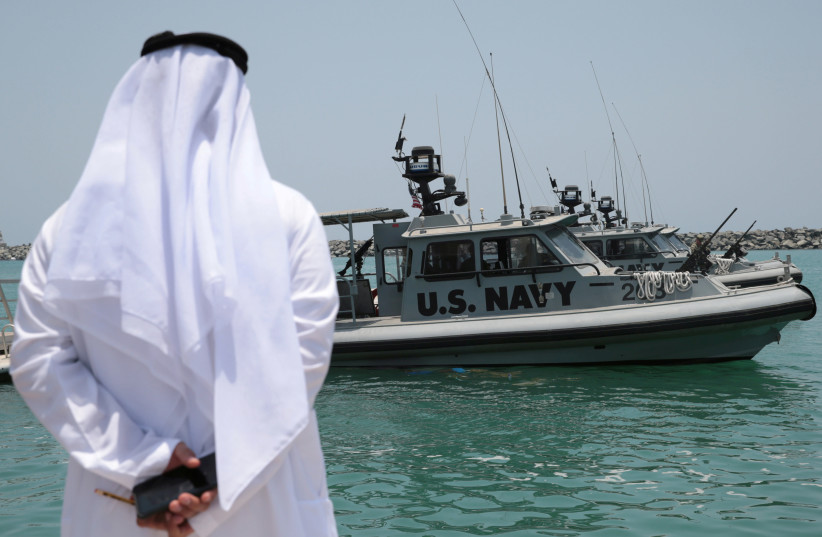The IDF has begun a joint, bilateral amphibious exercise with the US Naval Forces Central Command’s (NAVCENT) Fifth Fleet in Eilat for the second time in less than a month.
NAVCENT’s 51/5th Marine Expeditionary Brigade is leading the American participation in the drill, which will also see some 500 troops from the 11th Marine Expeditionary Unit, including a logistics battalion detachment, an infantry rifle company, a lightly armored reconnaissance company and a High Mobility Artillery Rocket System (HIMARS) platoon taking part.
IDF troops will include forces from the Commando Brigade’s Maglan unit, from the Lotar Anti-Terrorism Unit and from the School for Infantry Corps Professions and Squad Commanders.
“The troops will take part in a multibranch exercise for two weeks, in which they will train with counterterrorism forces, commando forces and expose-attack forces, simulating warfare techniques in open areas and urban environments,” the IDF said.
The two-week-long drill will include scenarios in urban terrain, infantry live fire, HIMARS live fire, and rapid maneuvering training. It will also see forces discuss various topics such as engineering, medical and explosive ordnance disposal.

“This exercise is part of the next chapter in the US Navy’s and Marine Corps’ long-standing relationship with Israel that is so vital to stability and security in the region,” Brig.-Gen. Farrell Sullivan, commanding general of the task force, was quoted as saying.
Last month, the Israel Navy participated in a combined maritime security patrol with NAVCENT’s Fifth Fleet in the Red Sea for the first time.
Three Israeli ships, the INS Eilat and two patrol boats, sailed alongside the guided-missile cruiser USS Monterey and a US Navy P-8A Poseidon maritime patrol aircraft that flew overhead.
The forces also practiced search and rescue scenarios, air defense, high-value unit defense, small boat operations, as well as tactical defensive maneuvers.
IDF naval operations head Brig.-Gen. Daniel Hagari said at the time that the strategic cooperation between the forces is vital for regional security and that of the State of Israel.
Following the drill, NAVCENT’s Fifth Fleet Commander V.-Adm. Brad Cooper visited Israel, meeting with senior officers to discuss mutual maritime threats.
During his visit, Cooper held meetings and briefings with Defense Minister Benny Gantz, IDF Chief of Staff Lt.-Gen. Aviv Kohavi and Israel Navy Commander V.-Adm. David Saar Salama, among others.
The Fifth Fleet’s area of operations covers some 2.5 million square miles and includes the Arabian Gulf, the Gulf of Oman, the Red Sea, parts of the Indian Ocean and three critical choke points at the Strait of Hormuz, the Suez Canal and the Bab al-Mandab Strait.
With Israel’s addition, the region now encompasses 21 countries.
The visit comes as a result of the transfer of the responsibility for Israel from the US Europe Command (EUCOM) to the US Central Command (CENTCOM).
It’s believed that the move will not only simplify cooperation with American troops in the region but can also create the potential for a regional coalition with Arab countries that have normalized ties with Israel against shared threats, including those posed by Iran.
The Fifth Fleet has sometimes clashed with Iranian vessels in the Gulf, and as tensions remain high, Israel’s addition can be seen as a message to Tehran.
On Tuesday evening, Gantz spoke with his American counterpart, Secretary of Defense Lloyd Austin, about continued cooperation between the two allies “vis-a-vis Iranian regional entrenchment and its nuclear aspirations,” he wrote on his Twitter page.
“We agreed to meet soon to deepen our discussion on strategic issues and military cooperation,” he added.
Earlier this week, the US Air Force flew a B-1B strategic bomber over key areas in the Middle East. It was escorted for part of its mission by allied aerial forces from Egypt, Israel, Jordan, Bahrain and Saudi Arabia.
The US Air Force heavy bomber, commonly called the “bone,” was headed to the Gulf in a show of presence.
“The joint flight illustrates the continued strategic cooperation of the IDF with the United States in the area,” the IDF said.
